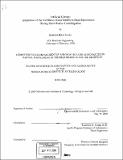Artificial gravity : adaptation of the vestibulo-ocular reflex to head movements during short-radius centrifugation
Author(s)
Sienko, Kathleen Helen, 1976-
DownloadFull printable version (11.59Mb)
Alternative title
Adaptation of the vestibulo-ocular reflex to head movements during short-radius centrifugation
Other Contributors
Massachusetts Institute of Technology. Dept. of Aeronautics and Astronautics.
Advisor
Laurence R. Young.
Terms of use
Metadata
Show full item recordAbstract
Short-radius centrifugation is currently being pursued as a potential countermeasure to long duration space flight. Short-radius centrifugation requires relatively high angular velocities (on the order of 30 rpm) to create centripetal accelerations on the order of 1 g. Unfortunately, out-of-plane head movements during centrifugation induce inappropriate vestibulo-ocular reflexes, debilitating motion sickness symptoms, and illusory tilt sensations due to conflicting visual and vestibular signals. Practical use of an intermittent short-radius centrifuge as a countermeasure requires that crew members be capable of rapidly adapting to the unexpected semicircular canal inputs with minimal side- or post-effects. Furthermore, adaptation not only has to be achieved, it also has to be appropriate for the environment (stationary, rotating, 1 g, or 0 g). The purpose of this research was to investigate humans' ability to attain and maintain adaptation to rotating environments. Subjects participated in a series of pre-/per-/and post-rotation data collection sessions consisting of both eye reflex recordings during head movements, a subjective battery of tests, and autonomic measurements. Eight subjects were tested on three days (D=1, 2, 8). Eye movements were measured in response to out-of-plane head movements during rotation at 23 rpm on-board the MIT short-radius centrifuge (r=2 m). Slow phase eye velocity (SPV) was reconstructed from filtered and de-saccaded eye movement data. The significant main effect of day and pre-/post-adaptation phase demonstrated that normalized SPV decreased following adaptation in the light.
Description
Thesis (S.M.)--Massachusetts Institute of Technology, Dept. of Aeronautics and Astronautics, 2000. Also available online at the MIT Theses Online homepage <http://thesis.mit.edu>. Includes bibliographical references (p. 89-93).
Date issued
2000URI
http://theses.mit.edu/Dienst/UI/2.0/Describe/0018.mit.theses%2f2000-68http://hdl.handle.net/1721.1/9237
Department
Massachusetts Institute of Technology. Department of Aeronautics and AstronauticsPublisher
Massachusetts Institute of Technology
Keywords
Aeronautics and Astronautics.